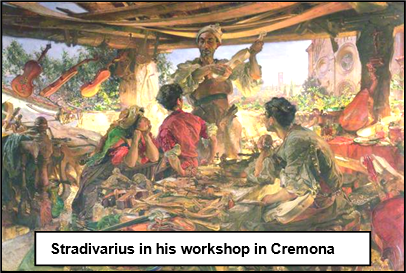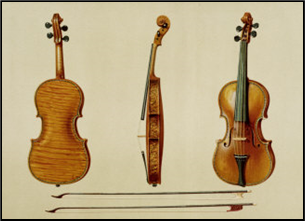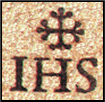


xxxxxThe Italian Antonia Stradivarius was the brilliant pupil of Nicolo Amati, the talented grandson of the violin maker Andrea Amati. He came to perfect the art of violin making, but the reason for his unique skill remains a mystery. It was probably due to the proportions of his instruments and/or the thickness and quality of the wood he used. He produced his first violin in 1666 and was still making instruments, including violas and cellos, at the age of 93. He opened his own workshop in 1680 and within ten years had started his Golden Period, two decades in which he produced the world’s finest violins, instruments perfectly balanced, and both mellow and strong in tone. In all, his workshop produced some 1100 violins, violas and cellos, and about half this number has survived, unequalled in quality, and virtually priceless.
ANTONIA STRADIVARIUS c1644 -
Acknowledgements
Stradivarius: romanticized portrait by the English artist Edgar Bundy (1862-
 xxxxxAs we have seen, Andrea Amati was the first of a celebrated Italian family of violin makers from Cremona. Working in the mid 16th century he produced some fine violins, together with a number of violas and cellos. The shape and style he developed was continued by his two sons, the "brothers Amati" (Antonio and Girolamo), but it was his talented grandson, Nicolo Amarti (1596-
xxxxxAs we have seen, Andrea Amati was the first of a celebrated Italian family of violin makers from Cremona. Working in the mid 16th century he produced some fine violins, together with a number of violas and cellos. The shape and style he developed was continued by his two sons, the "brothers Amati" (Antonio and Girolamo), but it was his talented grandson, Nicolo Amarti (1596-
xxxxxAntonio Stradivarius (Latin form of Stradivari), also came from Cremona. Underxthe guidance of his teacher Nicolo Amati, a craftsman of outstanding ability, he came to perfect the art of violin making, though the reason for his unique skill remains something of a mystery. It was probably due to the changes he made to the proportions of the instrument, but some put it down to the deep-

 xxxxxStradivarius made his first violin in 1666 and he was still making instruments at the age of 93, over 70 years later! He continued to work with Amati until 1684, but he opened his own workshop in 1680, and it was then that he began to make violins to his own specification. By 1690 he was producing what he called his "Long Pattern", a longer instrument with a shallower arch. Within ten years he had perfected his skill, and there then followed what has come to be known as his Golden Period -
xxxxxStradivarius made his first violin in 1666 and he was still making instruments at the age of 93, over 70 years later! He continued to work with Amati until 1684, but he opened his own workshop in 1680, and it was then that he began to make violins to his own specification. By 1690 he was producing what he called his "Long Pattern", a longer instrument with a shallower arch. Within ten years he had perfected his skill, and there then followed what has come to be known as his Golden Period -

xxxxxIncidentally, a contemporary rival to Stradivarius was the Italian Giuseppe Antonio Guarneri (1687-
C2-


